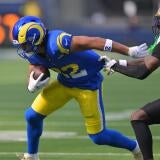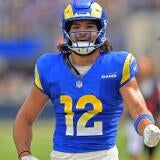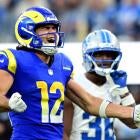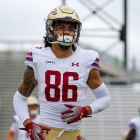Ranking top five NFL rookie RBs by who will be most productive in 2023, with first-rounders leading the way
These will be the most productive rookie running backs in their debut NFL seasons

Running backs were back on the board in the first round of the 2023 NFL Draft -- and therefore Bijan Robinson and Jahmyr Gibbs begin their pro careers with elevated expectations.
After the Robinson and Gibbs selections on Day 1, the position as a whole was littered with a diverse collection of talented runners; many, including myself, viewed it as one of the deepest ball-carrier draft classes in a while, maybe since the tremendous 2017 class that featured Christian McCaffrey, Dalvin Cook, Alvin Kamara, Joe Mixon, Aaron Jones, and Leonard Fournette. Can't forget that Austin Ekeler went undrafted in 2017, too.
These are the five running backs who'll be most productive in Year 1. I've also ranked receivers and tight ends by this same criteria.
5. Kendre Miller, Saints
I wavered back and forth here between Miller and Rams rookie Zach Evans. Keep an eye on the latter in Los Angeles. I trust Miller's make-you-miss capabilities more, which is why he ultimately got the nod here. We aren't sure if Alvin Kamara will get suspended at the outset of the 2023 season, and of course, if that happens, this ranking will be too low for the former TCU star.
Miller and Evans were actually part of the same backfield in 2021, and Miller averaged 7.5 yards per tote to Evans' 7.0 before Evans transferred to Ole Miss for his final collegiate season. A taller back, Miller has surprising contact balance, plus vision in tight spaces, and violent cutting ability. While Jamaal Williams will likely be deployed as the red-zone back in New Orleans after his remarkably productive 2022 with the Lions, I feel compelled to highlight Miller's 24 rushing touchdowns in his final two college seasons, including 17 (!) last year. There's ironically a lot of Kamara and Williams to his size and on-field style.
4. Roshon Johnson, Bears
I love the Bears backfield. Seriously. Some low-priced, high-upside veterans and some mid-round draft picks with a diverse collection of talent. That's how teams should fill out their running back room. Johnson is eerily similar to another former Texas Longhorns star, D'Onta Foreman, who, on paper, will begin training camp as Chicago's lead runner.
At 6-foot and 220 pounds with tree trunks for legs, Johnson calmly rips through tackle attempts from defensive linemen and linebackers alike. And that's not just an observational opinion. Johnson forced 86 missed tackles on his final 189 attempts in college. That equates to a preposterous forced missed tackle rate of 43.4%. And Johnson wasn't jump cutting linebackers in the hole too frequently. The vast majority of those missed tackles came via sheer, unadulterated power. Of course, the Bears are going to lean more on Justin Fields' arm in 2023. But Chicago toted the rock 558 times as a team during the regular season a year ago -- the second-highest figure in the league -- so there'll be plenty of handoffs to go around for this young and deep running back group. Johnson will surprise many with his effortless force as a ball-carrier en route to a fine rookie campaign.
3. DeWayne McBride, Vikings
You are seeing a seventh-round pick on this list, and I'm keenly aware of the history of seventh-round running backs in their debut NFL seasons. Isiah Pacheco's 830 yards on the ground during the regular season in 2022 was the second-highest total for a Round 7 rookie since the 1970 merger, and before his out-of-obscurity instant breakout, the last seventh-round runner to eclipse 500 yards as a rookie was Bryce Brown in 2012 for the Eagles.
I'm still standing behind McBride in this spot, and much of that confidence stems from my belief that he was far too talented on the field to be picked in the seventh round to begin with. McBride was a multi-year, ultra-efficient runner, and at 5-foot-10 and 210 pounds, he has ideal between-the-tackles size. Maybe his lack of a workout during the pre-draft process catalyzed what to me was a fall to the last round of the draft. He averaged 7.2 yards per carry during his three-year stay at UAB and forced 175 missed tackles on his 484 attempts. With just Alexander Mattison and Ty Chandler ahead of him on the depth chart, McBride has the juice to make a sizable impact on Minnesota's run game that's backed by a bulldozing offensive line.
2. Jahmyr Gibbs, Lions
Gibbs has much to contend with on his road to rookie-year productivity -- a pass-happy offensive coordinator, Amon-Ra St. Brown, and free-agent acquisition David Montgomery in the Lions running back room. But the Lions didn't select Gibbs inside the top 20 to have him undertake a background role in 2023. At Georgia Tech and Alabama, Gibbs was a rocket. From the backfield, on screens, as a slot receiver -- didn't matter. His free-flowing acceleration and elite top-end speed -- he ran 4.36 at the combine -- were always on full display.
Behind Detroit's upper-echelon offensive front, Gibbs will be provided ample space to operate, which is quite dangerous for opposing defenses. Even with Jared Goff spreading around the football, Gibbs will be a Swiss army knife for coordinator Ben Johnson en route to a relatively big rookie year.
1. Bijan Robinson, Falcons
Robinson steps into one of the game's most effective run games -- Atlanta was one of four clubs to manage a positive Expected Points Added total on the ground last season. He also has the top 10 draft pick label and immense hype from a highlight-reel collegiate career at the University of Texas.
While not as fast, there's plenty of Saquon Barkley to Robinson's size and play style. He stops on a dime and has the thickness to brush off weak tackle attempts as he bursts through the second level. His head coach, Arthur Smith, adores running the football -- the Falcons led the NFL with 559 attempts during the regular season in 2022 -- and even with productive teammates Tyler Allgeier and Cordarrelle Patterson still in the mix, I fully expect Robinson to shoulder the heaviest workload in Year 1. He's a forced missed tackle machine and flashed awesome ball-tracking skill on vertical routes for the Longhorns. Robinson was my May pick for Offensive Rookie of the Year.


















